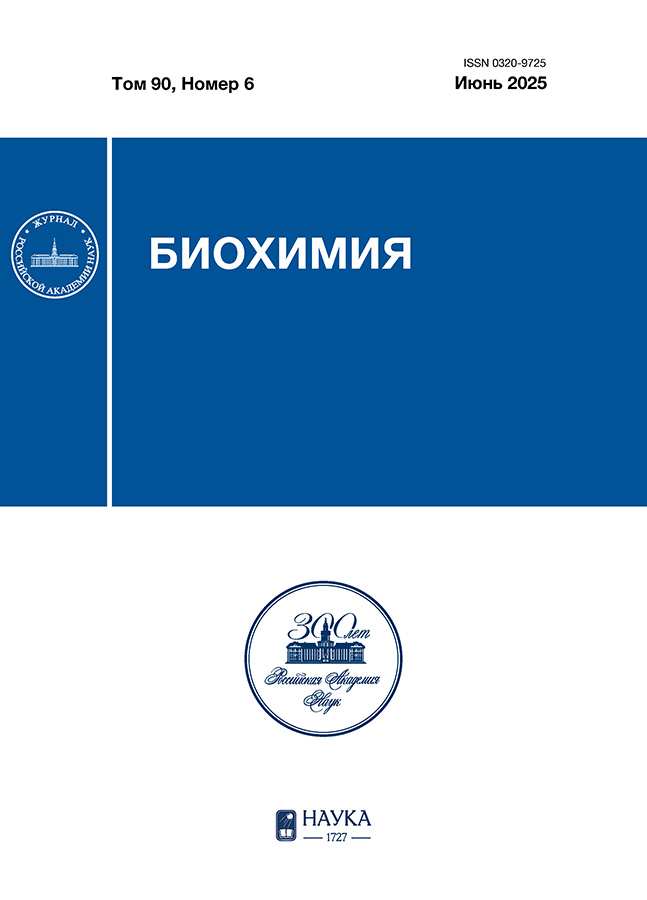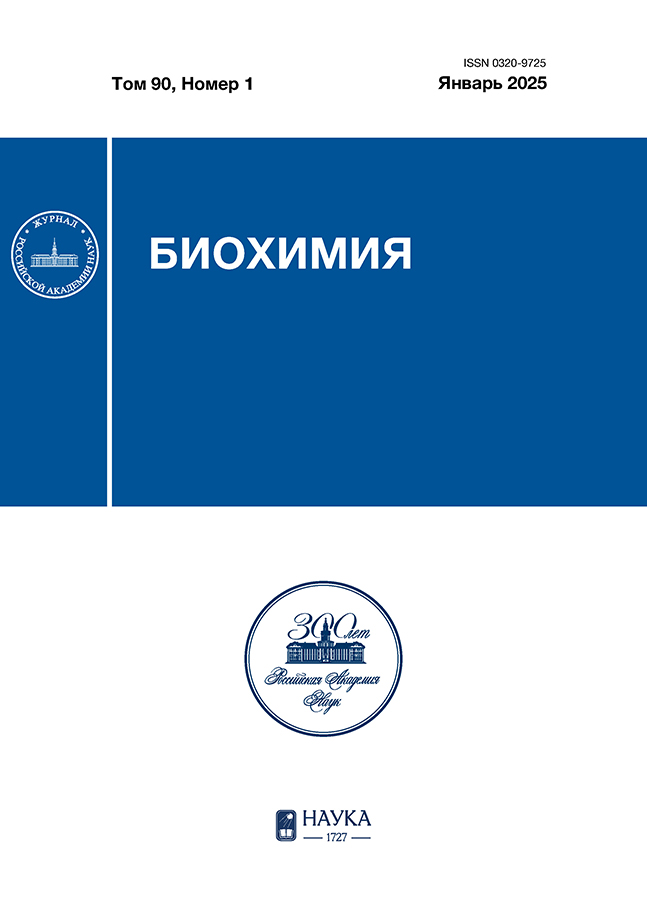Role of membrane proteins β- and α-structures in plasmalemm structure change
- Authors: Mokrushnikov P.V.1, Rudyak V.Y.1,2
-
Affiliations:
- Novosibirsk State University of Architecture and Civil Engineering (Sibstrin)
- Institute of Thermophysics
- Issue: Vol 90, No 1 (2025)
- Pages: 87-106
- Section: Articles
- URL: https://cardiosomatics.orscience.ru/0320-9725/article/view/682179
- DOI: https://doi.org/10.31857/S0320972525010064
- EDN: https://elibrary.ru/CPSLIG
- ID: 682179
Cite item
Abstract
Changes in the structure of plasma membranes affect the functions of membranes and cells. Some of these changes can lead to the development of pathologies of the body, which makes it actually to study the effect of changes in the structure of membranes on their functions. It has now been established that when stress hormones and androgens interact with plasma membranes, their structure changes. At the same time, interactions between proteins and lipids change in plasmalemmas, and a fixed quasi-periodic network of protein-lipid domains associated with the cytoskeleton is formed. The initiators of the formation of protein-lipid domains are membrane proteins, which have changed their secondary structure during the interaction of the membrane with hormones. However, it is still unclear exactly what changes in the secondary structure of membrane proteins contribute to the formation of protein-lipid domains around them. The aim of this work was to establish these secondary structures of membrane proteins. To achieve this goal, changes in the structure of membranes during their interaction with dehydroepiandrosterone, cortisol, androsterone, testosterone, and adrenaline were studied. In this work, a fluorescent method for measuring the relative microviscosity of membranes using a pyrene probe was used to study changes in the membrane structure. The change in the secondary structure of membrane proteins during structural transitions in membranes was studied by measuring the IR absorption spectra of membranes. It has been established that the initiators of the appearance of protein-lipid domains in plasma membranes are membrane proteins, in which, after interaction with hormones, the proportion of β-structures increases. At the same time, the appearance of new α-helices in membrane proteins does not enhance the attraction between membrane proteins and protein-lipid domains are not formed. On the contrary, the appearance of a large number of α-helices in membrane proteins can lead to a decrease in the microviscosity of the lipid bilayer.
Full Text
About the authors
P. V. Mokrushnikov
Novosibirsk State University of Architecture and Civil Engineering (Sibstrin)
Author for correspondence.
Email: pavel.mokrushnikov@bk.ru
Russian Federation, 630008 Novosibirsk
V. Ya. Rudyak
Novosibirsk State University of Architecture and Civil Engineering (Sibstrin); Institute of Thermophysics
Email: pavel.mokrushnikov@bk.ru
Russian Federation, 630008 Novosibirsk; 630090 Novosibirsk
References
- Боровская М. К., Кузнецова Э. Э., Горохова В. Г., Корякина Л. Б., Курильская Т. Е., Пивоваров Ю. И. (2010) Структурно-функциональная характеристика мембраны эритроцита и ее изменения при патологиях разного генеза, Бюллетень ВСНЦ СО РАМН, 3, 334-354.
- Боронихина Т. В., Ломановская Т. А., Яцковский А. Н. (2021) Плазмолемма эритроцитов и ее изменения в течение жизни клеток, Журн. Анат. Гистопатол., 10, 62-72.
- Mokrushnikov, P. V., Panin, L. E., and Zaitsev, B. N. (2015) The action of stress hormones on the structure and function of erythrocyte membrane, Gen. Physiol. Biophys., 34, 311-321.
- Мокрушников П. В., Панин Л. Е., Панин В. Е., Козельская А. И., Зайцев Б. Н. (2019) Структурные переходы в мембранах эритроцитов (экспериментальные и теоретические модели), Новосибирский государственный архитектурно-строительный университет (Сибстрин), Новосибирск.
- Mokrushnikov, P. V. (2019) In Lipid Bilayers: Properties, Behavior and Interactions (Mohammad Ashrafuzzaman, ed) Nova Science Publishers, New York, pp. 43-91.
- Мокрушников П. В. (2017) Механические напряжения в мембранах эритроцитов (теоретическая модель), Биофизика, 62, 330-335.
- Мокрушников П. В., Рудяк В. Я. (2023) Механическая модель образования складок на плазматической мембране, Докл. Акад. Наук Высш. Школы Российской Федерации, 59, 29-40.
- Panin, L. E., Mokrushnikov, P. V., Kunitsyn, V. G., Panin, V. E., and Zaitsev, B. N. (2011) Fundamentals of multilevel mesomechanics of nanostructural transitions in erythrocyte membranes and their destructions in interaction with stress hormones, Phys. Mesomech., 14, 167-177, https://doi.org/10.1016/j.physme.2011.08.008.
- Панин Л. Е., Мокрушников П. В. (2014) Воздействие андрогенов на активность Na+,K+-АТФазы эритроцитарных мембран, Биофизика, 59, 127-133.
- Куницын В. Г., Мокрушников П. В., Панин Л. Е. (2007) Механизм микроциркуляции эритроцита в капиллярном русле при физиологическом сдвиге pH, Бюлл. Сиб. Отдел. Росс. Акад. Мед. Наук, 5, 28-32.
- Мокрушников П. В. (2010) Влияние pH на поверхностное натяжение взвеси эритроцитов, Бюлл. Сиб. Отдел. Росс. Акад. Мед. Наук, 1, 38-46.
- Mokrushnikov, P. V., Rudyak, V. Ya., Lezhnev, E. V. (2021) Mechanism of gas molecule transport through erythrocytes’ membranes by kinks-solitons, Nanosystems Phys. Chem. Math., 12, 22-31, https://doi.org/10.17586/2220-8054-2021-12-1-22-31.
- Мокрушников П. В., Рудяк В. Я. (2023) Модель диффузии липидов в цитоплазматических мембранах, Биофизика, 68, 41-56.
- Dodge, J., Mitchell, C., and Hanahan, D. (1963) The preparation and chemical characteristics of hemoglobin-free ghosts of human erythrocytes, Arch. Biochem. Biophys., 100, 119-130, https://doi.org/10.1016/0003-9861(63)90042-0.
- Добрецов Г. Е. (1989) Флуоресцентные зонды в исследовании клеток, мембран и липопротеинов: монография, Наука, Москва.
- Dawson Rex, M. C., Elliot, D. C., Elliot, W. H., and Jones, K. M. (1986) Data for Biochemical Research, Clarendon Press, Oxford.
- ГСИ. Измерения косвенные. Определение результатов измерений и оценивание их погрешностей МИ 2083-90.
- Dembo, M., Glushko, V., Aberlin, M. E., and Sonenberg, M. (1979) A method for measuring membrane microviscosity using pyrene excimer formation. Application to human erythrocyte ghosts, Biochim. Biophys. Acta, 552, 201-211, https://doi.org/10.1016/0005-2736(79)90277-3.
- Владимиров Ю. А., Добрецов Г. Е. (1980) Флуоресцентные зонды в исследовании биологических мембран: монография, Наука, Москва.
- Yang, H., Yang, S., Kong, J., Dong, A., and Yu, S. (2015) Obtaining information about protein secondary structures in aqueous solution using Fourier transform IR spectroscopy, Nat. Protoc., 10, 382-396, https://doi.org/10.1038/nprot.2015.024.
- Barth, A., and Zscherp, C. (2002) What vibrations tell us about proteins, Quart. Rev. Biophys., 35, 369-430, https://doi.org/10.1017/S0033583502003815.
- Носенко Т. Н., Ситникова В. Е., Стрельникова И. Е., Фокина М. И. (2021) Практикум по колебательной спектроскопии, Изд. Университета ИТМО, СПб.
- Semenov, M. A., Bol’bukh, T. V., Kashpur, V. A., Maleyev, V. Ya., and Mrevlishvili, G. M. (1994) Hydration and stability of the β-form of LiDNA, Biophysics, 39, 47-54.
- Van Montfort, R., Slingsby, C., and Vierling, E. (2001) Structure and function of the small heat shock protein/alpha-crystallin family of molecular chaperones, Adv. Protein Chem., 59, 105-156, https://doi.org/10.1016/S0065-3233(01)59004-X.
- Vetri, V., D’Amico, M., Fodera, V., Leone, M., Ponzoni, A., Sberveglieri, G., and Militello, V. (2011) Bovine serum albumin protofibril-like aggregates formation: Solo but not simple mechanism, Arch. Biochem. Biophys., 508, 13-24, https://doi.org/10.1016/j.abb.2011.01.024.
- Sciandrone, B., Ami, D., D’Urzo, A., Angeli, E., Relini, A., Vanoni, M., Natalello, A., and Regonesi, M. E. (2023) HspB8 interacts with BAG3 in a “native-like” conformation forming a complex that displays chaperone-like activity, Protein Sci., 32, e4687, https://doi.org/10.1002/pro.4687.
- Killian, J. A., and von Heijne, G. (2000) How proteins adapt to a membrane-water interface, Trends Biochem. Sci., 25, 429-434, https://doi.org/10.1016/S0968-0004(00)01626-1.
- Montoyaa, M., and Gouaux, E. (2003) β-barrel membrane protein folding and structure viewed through the lens of α-hemolysin, Biochim. Biophys. Acta, 1609, 19-27, https://doi.org/10.1016/S0005-2736(02)00663-6.
- Довидченко Н. В., Леонова Е. И., Галзитская О. В. (2014) Механизмы образования амилоидных фибрилл, Усп. Биол. Хим., 54, 203-230.
- Sunde, M., and Blake, C. (1997) The structure of amyloid fibrils by electron microscopy and X-ray diffraction, Adv. Protein Chem., 50, 123-159, https://doi.org/10.1016/S0065-3233(08)60320-4.
- Кузнецов А. С., Дубовский П. В., Воронцова О. В., Феофанов А. В., Ефремов Р. Г. (2014) Взаимодействие линейных катионных пептидов с фосфолипидными мембранами и полимерами сиаловой кислоты, Биохимия, 79, 583-594.
- Ефремов Р. Г. (2015) Белки в мембранах: «хозяева» или гости? (по данным компьютерного эксперимента), Материалы VII Российского симпозиума «белки и пептиды». Новосибирск.
- Мокрушников П. В., Дударев А. Н., Ткаченко Т. А., Городецкая А. Ю., Усынин И. Ф. (2016) Влияние нативного и окислительно модифицированного аполипопротеина А-I на микровязкость липидного бислоя плазматической мембраны эритроцитов, Биол. Мембр., 33, 406-411, https://doi.org/10.7868/S0233475516060074.
- Ajees, A. A., Anantharamaiah, G. M., Mishra, V. K., Hussain, M. M., and Murthy, K. H. M. (2006) Crystal structure of lipid-free human apolipoprotein A-I, Proc. Natl. Acad. Sci. USA, 103, 2126-2131, https://doi.org/10.1073/pnas.0506877103.
- Acton, S., Rigotti, A., Landschulz, K.T., Xu, S., Hobbs, H.H., and Krieger, M. (1996) Identification of scavenger receptor SR-BI as a high density lipoprotein receptor, Science, 271, 518-520, https://doi.org/10.1126/science.271.5248.518.
- Ji, Y., Jian, B., Wang, N., Sun, Y., Moya, M. L., Phillips, M. C., Rothblat, G. H., Swaney, J.B., and Tall, A.R. (1997) Scavenger receptor BI promotes high density lipoprotein-mediated cellular cholesterol efflux, J. Biol. Chem., 272, 20982-20985, https://doi.org/10.1074/jbc.272.34.20982.
- Панин Л. Е., Тузиков Ф. В., Тузикова Н. А., Харьковский А. В., Усынин И. Ф. (1999) Влияние комплекса тетрагидрокортизол-аполипопротеин А-1 на биосинтез белка в гепатоцитах и на вторичную структуру эукариотических ДНК, Мол. Биол., 33, 673-678.
- Usynin, I. F., Dudarev, A. N., Miroshnichenko, S. M., Tkachenko, T. A., and Gorodetskaya, A. Yu. (2017) Effect of native and modified apolipoprotein A-I on DNA synthesis in cultures of different cells, Cell Technol. Biol. Med., 3, 247-251, https://doi.org/10.1007/s10517-017-3967-8.
- Bocharov, E. V., Okhrimenko, I. S., Volynsky, P. E., Pavlov, K. V., Zlobina, V. V., Bershatsky, Ya. V., Kryuchkova, A. K., Kuzmichev, P. K., and Efremov, R. G. (2024) Molecular interactions of β-amyloid peptides as disordered proteins and promising drugs based on D-enantiomeric peptides, in Bioinformatics of Genome Regulation and Structure/Systems Biology, Abstracts the 14th International Multiconference, Novosibirsk, https://doi.org/10.18699/bgrs2024-3.2-02.
- Бочаров, Э.В. (2024) Трансмембранный белок – предшественник β-амилоида в патогенезе болезни Альцгеймера и не только, Сборник тезисов докладов «VI Международной конференции ПОСТГЕНОМ’2024, XI Российского симпозиума «Белки и пептиды», Российско-китайского конгресса в области наук о жизни (ПСБ «Патриот», 29 октября–2 ноября 2024), стр. 263, М.: Издательство «Перо», [Электронное издание].
Supplementary files

















